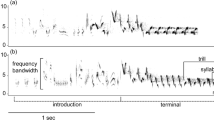Summary
-
1.
Males of the mole cricket, Gryllotalpa austrails (Orthoptera, Gryllotalpidae), produce their calling song from a specially constructed burrow, which has four horn-shaped openings at the surface of the soil.
-
2.
Males will also call from an artificial burrow with dimensions similar to the natural burrow, making it possible to study their wing movements during singing in the laboratory (Fig. 3).
-
3.
The calling song of G. australis is a continuous train of sound pulses with a mean frequency of 2.5 kHz (Fig. 4). The mean pulse repetition rate at 23°C is 70 Hz. Calling songs produced in the artificial burrows are similar to those produced in natural burrows.
-
4.
More than half the males studied in the artificial burrows sang with forewings arranged both right-overleft and left-over-right. Usually, males kept to one or other arrangement for the duration of a given calling song, but some males showed a propensity for changing wing arrangement during the song (Fig. 6).
-
5.
There was no significant difference between calling songs produced with the wings arranged right-over-left and those with the wings left-over-right, with respect to all major parameters including intensity (Fig. 5).
-
6.
The file and scraper structures are equally well developed on both left and right forewings of male G. australis (Fig. 7). The forewings lack the conspicuous group of sensory hairs that function to prevent a change of wing arrangement in field crickets.
-
7.
We conclude that mole crickets normally use both right-over-left and left-over-right wing arrangements in singing and that both are equally efficient at producing sound.
Similar content being viewed by others
References
Bennet-Clark HC (1970) The mechanism and efficiency of sound production in mole crickets. J Exp Biol 52:619–652
Bennet-Clark HC (1987) The tuned singing burrow of mole crickets. J Exp Biol 128:383–409
Elliott CJH, Koch UT (1983) Sensory feedback stabilizing reliable stridulation in the field cricket Gryllus itcampestris L. Anim Behav 31:887–901
Golda H, Ludwig W (1958) Rechts-Links-Fragen bei der Flügellage und dem Zirpen von Gryllotalpa vulgaris L. Zoolog Anz 161:1–11
Huber F (1962) Central nervous control of sound production in crickets and some speculations on its evolution. Evolution 16:429–442
Kavanagh MW (1987) The efficiency of sound production in two cricket species, Gryllotalpa australis and Teleogryllus commodus (Orthoptera: Grylloidea). J Exp Biol 130:107–119
Markin GP (1964) A lead-solder alloy casting technique for studying the structure of ants' nests. Ann Entomol Soc Am 57:360–362
Masaki S, Kataoka M, Shirato K, Nakagahara M (1987) Evolutionary differentiation of right and left tegmina in crickets. In : Baccetti M (ed) Evolutionary biology of orthopteroid insects. Ellis Horwood, pp 347–357
Nickerson JC, Snyder DE, Oliver CC (1979) Acoustical burrows constructed by mole crickets. Ann Entomol Soc Am 72:438–440
Regen J (1903) Neue Beobachtungen über die Stridulationsorgane der saltatoren Orthopteren. Arb Zool Inst Wien 14:359–422
Stärk AA (1958) Untersuchungen am Lautorgan einiger Grillen- und Laubheuschrecken-Arten, zugleich ein Beitrag zum Rechts-Links-Problem. Zool Jahrb Anat 77:9–50
Author information
Authors and Affiliations
Rights and permissions
About this article
Cite this article
Kavanagh, M.W., Young, D. Bilateral symmetry of sound production in the mole cricket, Gryllotalpa australis . J Comp Physiol A 166, 43–49 (1989). https://doi.org/10.1007/BF00190208
Accepted:
Issue Date:
DOI: https://doi.org/10.1007/BF00190208




